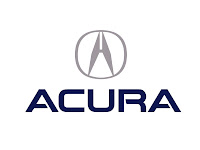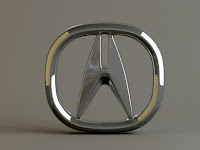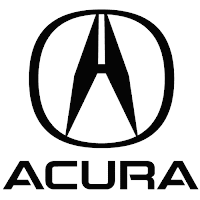Acura is the luxury vehicle division of Japanese automaker Honda Motor Company. The brand has been available in the United States and Canada since March 1986, marketing luxury, performance, and near-performance vehicles. It was introduced to Hong Kong in 1991, Mexico in 2004, and China in 2006. Honda's plan to introduce Acura to the Japanese market in 2008 was delayed, due to economic reasons, and later withheld as a result of the 2008 financial crisis.
 |
| Acura Logo |
The creation of Acura coincided with the introduction of a Japanese Honda dealership sales channel, called Honda Clio, which sold luxury vehicles, joining previously established Honda Verno, followed by Honda Primo the following year. Acura holds the distinction of being the first Japanese automotive luxury brand. In its first few years of existence, Acura was among the best-selling luxury marques in the US. Though sales were down in the mid-to-late 1990s, the brand experienced a revival in the early 2000s, due to drastic redesigns and the introductions of new models.
History
1980s: Introduction of the Acura brand
Following a decade of research, Honda opened 60 new dealerships in North America by 1986, to support its Acura automobile division. Acura was the first Japanese luxury brand, introduced under the slogan, "Acura. Precision Crafted Performance." Its initial offering consisted of two models: the executive class Legend and the compact class Integra, available as a five-door and three-door hatchback. The Legend was the result of Project XX, a joint venture Honda entered into with the UK's Austin Rover Group. It was mechanically related to the Rover 800 series, while the Integra was an improvement of the Honda Quint hatchback.
 |
| Acura Logo |
The success of these models, particularly the Legend, led to competing Japanese luxury brand ventures (Toyota's Lexus that began development in 1983 as the F1 project, and Nissan's Infiniti who began development in 1985 by revising their Japan-only flagship Nissan President; in the late 1990s Mazda planned but never launched its own Amati luxury division). The goal of the Legend was to compete with rivals Toyota Crown and the Nissan Cedric and Gloria, but due to its 1986 introduction worldwide, Toyota, Nissan and other companies like Lincoln took notice of the markets reaction to the Legend and later the Vigor and offered vehicles that addressed the executive size car. Toyota introduced the Lexus ES, Nissan introduced the Infiniti J30 and Lincoln utilized the Taurus platform and named their new sedan the Continental.
In 1987, Acura's first full year of sales, they sold 109,000 cars with the flagship Legend sedan accounting for 55,000 sales and the rest were of the smaller Integra. By 1990, Acura was selling 138,000 vehicles, including 54,000 Legends, compared to Mercedes-Benz's 78,000 cars and 64,000 each for BMW and Lexus.
1990s: NSX, updates
In 1991, five years after the debut of the Legend and Integra, Acura introduced the NSX, a midship V6 powered, rear-wheel-drive sports car. The NSX, an acronym for "New Sports eXperimental", was billed as the first Japanese car capable of competing with Ferrari and Porsche. This vehicle served as a "image car" for the Acura brand, heralding the introduction of Honda's VTEC technology. The NSX was the world's first all-aluminum production car, and was also marketed and viewed by some as the "Everyday Supercar" thanks in part to its ease of use, quality and reliability, traits that were unheard of in the supercar segment at the time. With the release of the NSX, Acura introduced the "A-badge", a stylized pair of calipers—a tool used for exacting measurements to imply that Acura vehicles are built to precise and demanding standards.
 |
| Acura Logo |
Despite a strong start in market acceptance for the Acura brand, sales suffered in the mid-to-late 1990s. Some critics attributed this decline in part to less inspiring designs, which were re-branded Japanese-spec Hondas, such as the Acura Vigor in 1992, a response to the Lexus ES and Infiniti J30. Additionally, during this time Acura switched to an alphanumeric nomenclature formula, dropping the Legend, Vigor and Integra titles, following the lead of the NSX sportscar. The 1996 3.5 RL, which replaced the popular Legend, and the Vigor became the 2.5 TL and 3.2 TL, and was regarded by many as the epitome of this problem, namely because the alphanumeric designations were more anonymous than the former Legend, Vigor and Integra titles, which had grown into their own cult followings.[6] Also, the RL's 210 horsepower (160 kW) V6 (later increased to 225 hp), together with a high price and styling that cautiously copied the larger rear wheel drive and V-8 powered Lexus LS 400, did little against BMW, Audi, Lexus, and other competitors.
The parent company, Honda, was also feeling the results of the decline of the Japanese economy, due to the Japanese asset price bubble that took place during the 1990s and into the 2000s. This period is known in Japan as The Lost Decade.
During this time, the NSX also lost sales as Acura made few changes from its original 1990 trim. A year later, the Integra sedan was withdrawn from the Canadian market, replaced by the market-exclusive Acura 1.6 EL, a rebadged Honda Civic/Domani. The Integra sedan continued to be sold in the United States until 2001 (in name only, the model it was replaced with, the RSX, was simply a rebadged left-hand-drive version of the JDM DC5 Honda Integra).
The Acura 3.2 TL
Despite these letdowns, Acura gained prominence in the 1990s with a young group of customers: "tuner" enthusiasts. Parent company Honda's reputation with this demographic as a maker of "easy-to-tune" and "rev-happy" engines rubbed off onto Acura, and the Integra became a popular tuner car.
2000–2003: TL, RSX, MDX
Beginning around the year 2000, Acura experienced a rebirth which was catalyzed by the introduction of several redesigned models. The first of these models was the 1999 Acura 3.2 TL, an upscale sedan competing with the likes of the Lexus ES, Infiniti I30, and BMW 3-series. Critics suggested that although 3.2 TL did not outdo its competition in any one area of luxury cars, it offered a well-rounded blend of sportiness and luxury. These characteristics, combined with the TL's competitive price, proved very popular with consumers. Subsequent Acura models have followed a similar philosophy of offering lots of standard equipment and very few options.
 |
| Acura Logo |
nother refreshed Acura introduced in the early 2000s was the MDX, a popular three-row crossover SUV based on the Honda Odyssey minivan. The MDX replaced the slow-selling SLX, which was little more than a rebadged Isuzu Trooper. The MDX was a car-like crossover SUV with limited off-road capability that catered to the demands of the luxury SUV market. It was given top honors by Car and Driver in its first comparison test against seven other SUVs.[8] Other cars in Acura's line-up during this time included the 3.2 TL, 3.2 CL, RSX (formerly the Integra hatchback), and the NSX. By the late 2000s, Acura had dropped the inclusion of engine displacement numbers in its vehicle designations, retaining a simpler, two- or three-letter designation instead (e.g. 3.5 RL became RL). The 1999-2003 TL have been plagued by transmission and other problems.
In 2001, a new coupe, badged as the RSX was introduced to the Acura line up. It was a replacement for the outgoing Integra. The RSX is a rebadged Honda Integra (DC5) from the Japanese market. As a result, the RSX is technically a new generation of the outgoing Integra. Much like the Integra, the RSX was a hit in the tuner market. However, at the end of 2006, the RSX was taken out of the Acura line up, subsequently in the Japanese market as well. It is not known why the RSX did not continue to be sold as the Integra in Japan, however, the reason that Acura gave for the cancellation of the RSX is that Acura wishes to move up in the luxury brand, thus cannot sell a car that is mostly driven by teenagers.
2004–2006: RL, TSX, RDX
A new TL debuted for the 2004 model year, featuring sharp, Italianate styling and a 270 hp (200 kW) V6 measured by the then-current SAE standards. The new TL increased sales dramatically to 70,943 American units in 2005, trumping competitors such as the C-Class, G35, CTS, ES 300, and A4.
Also around the same time the Acura TSX was introduced as a cheaper alternative to the BMW 3-Series. It was essentially a re-badged European and Japanese market Honda Accord loaded with features. This model became the only 4-cylinder sedan in Acura's line-up (with the exception of the Canadian market Acura CSX, which replaced the EL in 2006).
.jpg) |
| Acura Logo |
In 2005, a new RL was introduced with a 300 hp (220 kW) V6, improved styling, and Super Handling All-Wheel Drive (SH-AWD), a system capable of sending almost all of the RL's power to just one wheel in a turn. The second-generation RL appeared on Car and Driver's Ten Best list for 2005, and also garnered an CNET.com "Editor's Choice" Award for Top Tech Car. While critically acclaimed, sales have not met expectations, as the price of the RL is perceived to be out of its bracket. As the new RL offered more features and performance than the base version of its luxury competition's (i.e., the base six-cylinder. BMW 5 Series), Honda Japan suggested that it could charge more, though Honda Canada disagreed. The RL's initial MSRP was $69,500 CAD, more than the six-cylinder BMW 525i and close to that of the V8-powered BMW 545i. At the RL's price point, most consumers expected a V8, furthermore they did not perceive Acura as being on par with its German rivals and expected more value from the Japanese marque. The damage from Honda Japan's alleged hubris was done, even though Honda Canada has since reduced the RL's price.
Acura's new models—particularly the TL and TSX—were well received by the motoring press and became Acura's top selling vehicles. The TSX was on Car and Driver's Ten Best list from 2004–2006.
In 2006 Acura introduced a small SUV which was based on its own unique unibody chassis called the RDX with models becoming available to U.S. consumers in August 2006. It is powered by a turbocharged 240-hp 4-cylinder engine and, like the RL, uses Acura's SH-AWD system. The model is available in two versions: Premium (the standard offering), and Technology Package (an upgraded offering with a GPS navigation system). A completely redesigned MDX became available in the fall of 2006 with a 300 hp (220 kW) V6 engine and Super Handling All-Wheel Drive.
2007–present: ZDX, ILX
Acura re-introduced the TL Type-S for the 2007 model year. 2009 marked the all new TL and TSX models as well as a mid-year model update for the RL; all three made their debuts in the 2008 calendar year. Acura planned on redesigning the RL by 2011 as well as announced the creation of a brand new luxury crossover vehicle called the ZDX, previewed by the concept of the same name.
.jpg) |
| Acura Logo |
The ZDX was the first Acura designed in Acura's design studio located at Torrance in Southern California. The ZDX was designed by Michelle Christensen and based on the Acura MDX using that vehicles 3.7 litre V6 engine (300 bhp) and SH-AWD system. A common misconception is that it is based on the Honda Crosstour which was based on the Honda Accord rather than the bigger and more complex underpinnings of the MDX. It is also the first Acura to be completely built in North America. The production model of the ZDX made its debut in the Orange County Auto Show in Southern California on October 15, 2009. The concept behind the ZDX is that it is a "four door coupe," and the design emphasis of the body of the car is like a "pulled back slingshot." Another prominent design aspect of the ZDX is the wide rear shoulders above the rear wheels. The ZDX went on sale in December 2009.
Acura initially had plans for the third generation of RL to be a rear wheel drive V8 sedan for its flagship, but shelved the plans in the wake of the 2008 economic downturn.
Acura announced new TSX wagon in the 2010 New York Auto Show and the car is due to go on sale in Fall of 2010. The wagon version of the TSX is based on the wagon version of the Euro-spec Honda Accord which has been in the European market for some time. No plans for brand new RL have been released to date.
For the 2010 model year the MDX models received some slight exterior changes and increased equipment levels. Mechanically the engine remained unchanged but the transmission was updated from the previous 5-speeds to 6-speeds including steering column mounted shift override paddles. This new transmission was shared with the ZDX.
In 2012, Acura introduced a new model called the ILX which is based heavily on the Honda Civic platform. It shares the same 3 power train variants from the Civic: the 2.0L, 2.4L VTEC and a 1.5L Hybrid. The ILX went on sale in May 2012 in the United States as a 2013 model.
Timeline
1986
Acura debuts in North America as the first Japanese luxury marque.
1990
Acura dealerships in the US win their fifth consecutive first-place ranking on the Customer Satisfaction Index by J. D. Power and Associates
Acura announces that it will expand research and development in the US
The second generation Integra is introduced
1991
The Legend coupe wins Motor Trend's prestigious "Import Car of the Year" trophy
Honda's VTEC technology is introduced in the NSX
Acura is introduced in Hong Kong by Reliance Motors
1992
The Legend and Integra are joined by the Vigor
1994
The third generation Integra is introduced
1996
The CL is introduced as a 1997 model
The Legend is replaced by the RL and the Vigor is replaced by the TL
1997
The Integra Type R is introduced
The NSX receives 20 more horsepower with a larger 3.2L V6 engine and a new 6-speed manual transmission
The Civic-based 1.6 EL replaces the Integra sedan in the Canadian lineup, while the Integra sedan continued U.S. sales until 2001
2000
The MDX is introduced as a 2001 model along with a new CL
2001
The MDX wins the prestigious Motor Trend "2001 Sport/Utility of the Year" award
Civic-based 1.7 EL launched, replacing the 1.6 EL, in the Canadian lineup
2002
The Integra is replaced by the RSX, which is a left hand drive version of the fourth generation Honda Integra
The TL Type-S is introduced
The NSX receives a cosmetic facelift, with the retractable headlights being replaced with fixed ones. The suspension is also slightly revised, and an automatic transmission becomes optional
2003
The CL receives a new 6-speed manual transmission, before being discontinued later that year
2004
Acura is introduced in Mexico by Honda de Mexico
Third generation Acura TL is introduced
The TSX is introduced and becomes a very competitive choice against popular BMW 3-series
The MDX receives a mid-model change with more horsepower
2005
The NSX is discontinued
The RSX receives a mid-model change and more horsepower in the Type-S
The new Acura TL wins "Consumer's Most Wanted Vehicle" at Edmunds.com
Acura RL is introduced with the revolutionary SH-AWD system
Acura drops engine size from 1.7 EL model name
2006
Acura is introduced in China
Acura RDX is introduced with SH-AWD
Acura introduces CSX to replace EL, and is only sold in Canada
The RSX (as well as the Honda Integra) is discontinued
The TSX gets mid-model change with 5 more horsepower
2007
Acura MDX receives a redesign
Acura TL Type-S is reintroduced, and the CSX Type-S is introduced in Canada
2008
Acura introduces the new RL, which receives a mid-model change redesign
Acura introduces new TSX at the New York Auto Show
2009 model year
Acura TSX receives a redesign
Acura TL receives a redesign
Acura RL receives a mid-model change
Acura CSX receives a mid-model change
2010 model year
Acura introduces all new ZDX
Acura MDX receives a mid-model change
Acura RDX receives a mid-model change
Acura TSX receives an optional V6 engine from the TL and a minor mid-model change
2011 model year
Acura TSX Sport Wagon is introduced
Acura CSX is dropped
2012 model year
Acura TL gets mid-model change
Acura TSX Special Edition is introduced
2013 model year
Acura ILX is introduced
Acura RDX receives a redesign
Articles By : en.wikipedia.org/wiki/Acura
